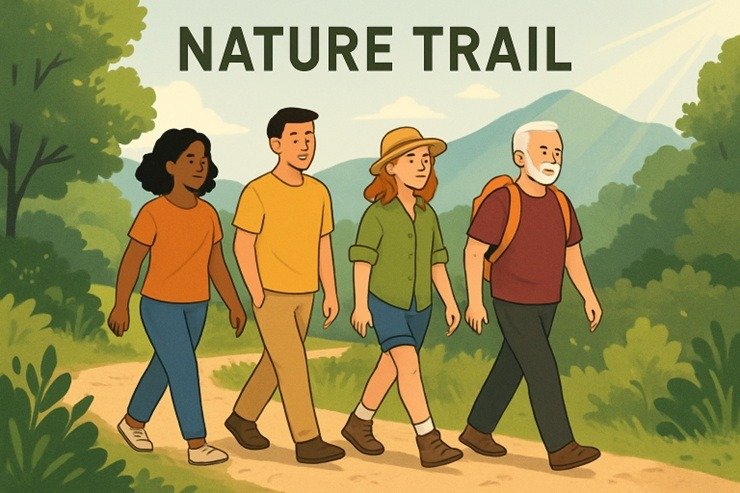Lifestyle
Scenic Trails and Wellness Benefits for Outdoor Enthusiasts

Key Takeaways
- Scenic trails support cardiovascular fitness, muscle strength, and whole-body physical wellness, allowing for adaptable routines that suit users of all activity levels.
- Time spent outdoors can reduce symptoms of anxiety, stress, and depression while increasing happiness and mindfulness—key contributors to long-term well-being.
- Trails bring people together, creating opportunities for socialization, inclusivity, and stronger communities through group hikes and shared outdoor experiences.
- Conservation is advanced through responsible trail use and maintenance, which safeguards wildlife and natural habitats for future generations to enjoy.
- Trail-based tourism boosts local economies by attracting visitors, generating jobs, and supporting small businesses that rely on outdoor recreation.
Exploring scenic trails offers adventure, tranquility, and wellness for outdoor lovers. These paths wind through diverse landscapes like forests, mountains, lakeshores, and parks, encouraging physical activity and mental clarity. They also foster connections with nature and others, sharing curiosity and wonder beyond daily routines. Whether your trek takes place on rugged mountain routes or accessible urban paths, the journey is further enriched by immersing yourself in guided hiking tours in Utah and other unique natural wonders. Embarking on such journeys means embracing both personal growth and community bonds—immersion into the outdoors fosters not only fitness but also a renewed perspective on life itself.
Trails provide more than exercise—they offer mental refuge, a break from stresses, digital disconnection, and community building. They foster environmental stewardship and, through well-designed trails, improve individual lives while benefiting neighborhoods and communities.
Physical Health Benefits
Regular trail activity, from brisk walking to challenging hikes, boosts cardiovascular endurance and fitness. It targets different muscles, increasing flexibility and coordination through movements like climbing and descending slopes. The varied terrains—gentle inclines, shaded forests, rocky climbs, and switchbacks—engage stabilizing muscles, improving balance and agility. Moderate hiking benefits the heart, regulates blood pressure, and strengthens legs, back, and core, supporting lifelong mobility. Hiking is a top full-body exercise, offering aerobic and resistance training. Regular trail walks enhance stamina, posture, and sleep, demonstrating the benefits of outdoor activity.
Mental Well-Being
Getting away from city noise and digital distractions benefits mental health. Natural landscapes with fresh air, sunlight, and peaceful sounds reduce stress hormones and alleviate tension and anxiety. Trails boost emotional resilience, creativity, and mindfulness. Green spaces improve mood and lower depression risk, as research shows. Outdoor activities increase clarity and revitalization. Disconnecting from screens and engaging with nature helps manage the pressures of modern life, making outdoor time vital for overall wellness.
Social Connections
Trails are vital social spaces that foster connections among hikers, families, and group leaders from all backgrounds. Whether at community hikes, charity walks, or informal sharing, participants benefit from positive interactions that combat isolation. Group activities promote teamwork, communication, and a sense of belonging, bridging generational and cultural gaps—grandparents with grandchildren or newcomers with residents—while engaging in healthy pursuits. The rise of hiking clubs and outdoor meetups shows their power to create lasting friendships and community bonds. Everyone, regardless of experience or ability, can enjoy the supportive, inclusive environment that turns outdoor outings into meaningful connections.
Environmental Conservation
Beyond personal wellness, responsible trail use is vital for environmental stewardship. Well-maintained trails protect landscapes, prevent erosion, and support habitat connectivity. They help channel human impact, letting ecosystems regenerate. Educated outdoor enthusiasts who follow “Leave No Trace” principles are more likely to protect native environments. By staying on trails, reducing waste, and respecting guidelines, users aid conservation. Community projects and volunteer efforts deepen commitment to preserving wild places. Thus, outdoor recreation raises awareness about environmental issues and encourages stewardship globally.
Economic Impact
Trail activities impact economies beyond recreation, attracting millions to scenic trails in cities and remote areas. They support local businesses like outdoor retailers, restaurants, lodging, and tours. Well-developed trails boost demand for rentals, guides, and retreats, fostering entrepreneurship and jobs. Washington state alone reports over $8.2 billion in annual economic contributions from outdoor recreation, as detailed by the Washington State Recreation and Conservation Office. This dynamic sector not only increases tax revenue and local spending, but also encourages further investment in trail maintenance, infrastructure upgrades, and environmental education programs. The overall improvement in quality of life, through enhanced outdoor amenities, benefits residents and visitors alike, supporting healthier and more vibrant communities.
Accessibility and Inclusivity
Progressive trail design makes outdoor experiences accessible for all, reflecting societal commitment to inclusivity. Modern trails feature paved surfaces, accessible restrooms, tactile wayfinding, shaded seating, and safety features. These accommodations help everyone, including those with mobility issues or families with strollers, enjoy outdoor recreation. Prioritizing inclusivity through universal design opens opportunities for underserved communities to benefit from nature. Partnering with disability advocates, translating signage, and community outreach further increase participation, ensuring the health and wellness benefits of trails are available to everyone.
Safety Considerations
Preparing for a trail outing boosts safety and enjoyment by preventing injuries and ensuring a positive experience. Hikers should check the weather, wear appropriate clothing and sturdy shoes, and pack water, snacks, and emergency supplies. Knowing the route’s length, terrain, and difficulty helps set realistic expectations and avoid risks. Sharing plans, carrying a map or GPS, and checking trail advisories are key safety steps. Follow guidelines for wildlife and keep pets leashed and waste managed. Proper preparation and common sense make outdoor adventures safe and memorable.
Conclusion
Scenic trails are vital for promoting wellness, fostering community, and preserving the environment. Choosing to walk, bike, run, or hike on trails invests in health, connects people, and supports ecosystems. They improve the quality of life and help preserve natural and social resources for future generations. Trails are accessible to all, enabling us to explore new landscapes, achieve personal goals, and maintain outdoor spaces that benefit both people and the planet.
-

 Quotes3 years ago
Quotes3 years ago53 Motivational Gym Quotes to Fuel Your Workout
-

 Quotes10 years ago
Quotes10 years ago50 Most Powerful Quotes Ever Spoken
-

 Motivation5 years ago
Motivation5 years ago4 Fun New Hobbies To Try This Year
-

 Quotes1 year ago
Quotes1 year ago100 Motivational Quotes to Inspire You in 2025
-

 Quotes2 years ago
Quotes2 years ago43 Inspirational Quotes About Thoughts
-

 Quotes3 years ago
Quotes3 years ago105 Motivational Quotes by Famous People
-

 Education12 months ago
Education12 months agoHow to Motivate Yourself to Study: 6 Proven Techniques
-

 Quotes1 year ago
Quotes1 year ago77 Morning Motivational Quotes to Kickstart Your Day
































